Adapted from Susan Gilchrist, Wisconsin DNR
“Permission to use this correspondence has been given by the author, Susan Gilchrist, and the Iowa Dept. of Natural Resources.”
- Introduction
- Awareness and Appreciation
- Sensory Appreciation
- Wild and Domestic
- Food Chains
- Carrying Capacity
- Human Impact
- Extinction
- Adaptation
- Habitat
- Anthropomorphism
Introduction
Young children are interested in animals. Many activities and stories for young children revolve around them. What are we teaching these eager learners? That the lion is king of the jungle? That predators are mean because they eat other animals? That wolves wear pants? It isn’t necessary to know many specific facts about individual species of animals to create an appreciation of wildlife and an understanding of some of the basic workings of the natural world.
Here are a few ideas for teaching children about wildlife. You can incorporate concepts about wildlife into your regular activities by the way you talk about wild animals; it is not necessary to focus a whole unit on wildlife, unless you choose to do that. Part of appreciating wild animals is noticing them where they live, all around us; part is recognizing that each animal has a part to play in the larger balance of things; part is accepting that the balance of nature is not static, but continually fluctuates.
Awareness and Appreciation
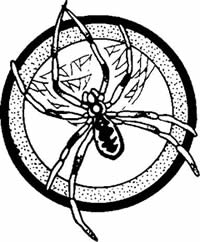
Overturn a rock, a log, or even a pile of leaves outside and look there for bugs. If you find a cocoon, keep it in a place where there will be plenty of room for the butterfly or moth to open wide its wings when it emerges. Do various activities with tracks in the snow: play “Hide-and-Seek” or “Follow the Leader” by following footprints. Carefully observe tracks of birds, dogs, cats, people, and talk about their different kinds of feet. How do duck footprints look different from pigeon footprints? Do art activities with tracks. Draw around childrens’ feet or have them make tracks by walking in paint and then on paper. If you have a stamp of wild animal tracks, children can stamp the path an animal has taken across a picture of a place where wild animals could live.
There are basic things you can do to increase awareness about wildlife and begin to build appreciation. Even in a city, there are many wild animals. Talk about signs of wildlife: tracks in the snow or mud, a feather, scat droppings, nibbled leaves, a spider’s web, marks on the bark of trees, nests in trees, holes in the ground, or other animal homes. Look for signs of wildlife in the basement, back yard, a nearby park, or on a walk around the block. Talk about your findings.
Talk about fears some people have of some animals, the unhuggables (e.g., insects, spiders, bats, snakes, frogs, sharks, wolves, etc.). Bats don’t really attack people to suck their blood, but they do eat a tremendous number of insects that we consider pests. Snakes are friends of farmers because they eat the mice and other rodents that eat the farmers’ grain. Mosquitoes are pretty irritating to people, but play an important role in the food chain for birds, reptiles, amphibians, fish, and other insects. Each animal has its niche, its place in the world. These creatures generally are not trying to attack people; most are frightened of us. Point out the difference between being startled by a daddy longlegs running across your toes and being terrified of all spider-like creatures. Draw a picture of an animal that frightens you. Does it look scary in the picture? What makes it look scary, if it does?
Go on a walk to look for worms or worm casings, one sign that they’ve been working the soil there. After a rain, rescue some worms (that originally left the dirt to avoid drowning) from drying out on the sidewalk by returning them to the earth.
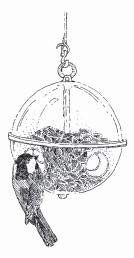 Collect a few worms in a clear plastic container with some dirt, a few drops of water, and a little food to make a worm farm. Which will the worms eat first: a piece of apple, a bit of lettuce, or crumbles of bread? Worms do important work aerating the soil.
Collect a few worms in a clear plastic container with some dirt, a few drops of water, and a little food to make a worm farm. Which will the worms eat first: a piece of apple, a bit of lettuce, or crumbles of bread? Worms do important work aerating the soil.
Put out bird feeders, then watch birds come to feed. Notice the different colors and kinds of birds and how they behave. Different kinds of bird seed draw different kinds of birds. For example, woodpeckers like suet; gold finches eat thistle seed. There are a multitude of easy-to-make bird feeders. Children can spread peanut butter on pinecones; hang lumps of suet (available at the meat counter in grocery stores) in mesh bags or onion sacks; cut empty milk cartons, plastic jugs, or plastic soda bottles into feeders; or help construct a wooden tray.
Partially fill feeders with thistle seed, sunflower seeds, millet, peanuts, cut up apples, pumpkin or squash seeds, raisins, currants, or bread crumbs. Be sure to clean up residue from bird feeders regularly, to prevent the spread of disease among the birds. For winter birdfeeding, begin mid-September and continue through mid-April.
Sensory Appreciation
Many animals possess acute sensory abilities. The eagle can see great distances; bats hear sounds we miss entirely; wolves have a keen sense of smell.
Divide children into two groups. Prepare little vials (film canisters with holes in their lids are excellent) with things that have strong, though not necessarily unpleasant, scents in them. Examples include: a section of orange, a cinnamon stick, a piece of pine, almond or other extract on a cotton ball, dried mint leaves, fennel or anise, perfume, flowers, coffee beans, tea, or herbs. Pass out matching pairs of scent vials. Have each group try to find the matching scent vial in the other group. Discuss the way animals frequently recognize each other by scent.
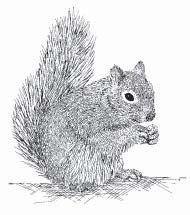 Play a similar game with sounds. Have children recognize their partner in the other group by the sound she/he makes. You could assign sounds such as wolf howls, bear grunts, crow caws, squirrel chatterings, bison snorts, lion roars, porcupine teeth clickings, bird whistles, etc. As the two groups
Play a similar game with sounds. Have children recognize their partner in the other group by the sound she/he makes. You could assign sounds such as wolf howls, bear grunts, crow caws, squirrel chatterings, bison snorts, lion roars, porcupine teeth clickings, bird whistles, etc. As the two groups
Have a color scavenger hunt. Give children paint chips or squares of colored paper and send them outside to find things that match the colors of their paper squares. They don’t have to bring anything back; they can just tell you
Play recordings of wolf howls, loon calls, or frog or bird songs. Point out the loveliness of these natural songs. Allow children the opportunity to mimic them. Listen to a bird outside the window. Talk about animal communications. Many animals use their voices to communicate warning, make threats, announce their presence, invite company, divulge the location of food, or proclaim their territory.
Some animals communicate in ways we may not understand immediately. Bees communicate through a dance. Many animals communicate through scent. Deer attract a mate through scent; ants communicate where food has been found through scent; and skunks communicate warning through release of scent. A beaver slaps its tail on the water to warn of danger. Have children talk about how they communicate fear or aggressiveness with body language and with words.
Art projects are wonderful, tactile ways to appreciate wildlife. Talk about the variety of beautiful colors and special patterns that cover different animals. Talk about the colors and patterns as adaptations for survival, such as the spotted fawn that disappears along the forest edge, the bright colored plumage that attracts a mate to a male bird, or the red skin on the crane’s crown that can deter other intruding cranes. Make a mosaic picture of a bird or mammal by gluing different colored leaves in the appropriate shape on paper. Color broken egg shells and glue shell bits onto paper in the shape of turtle or snail shells. Glue rocks together to make turtles, bears, or whatever suits the artist in you. Paint the eyes and any other important features. Draw animal outlines in sand or snow with a stick.
Wild and Domestic
While you are enhancing awareness and appreciation for wildlife, you also can teach some basic concepts, vocabulary, and principles. Talk about the difference between wild (animals that live on their own independent of human assistance) and domestic (pets or farm animals; animals that depend on humans for food and shelter) animals. Show magazine pictures of animals (or use plastic animals) and ask whether each animal pictured is wild or domestic. Remember that wild animals are not necessarily ferocious: consider the chipmunk, box turtle, mallard duck. At the other end of the scale, there are some domestic animals, such as cats, that have become wild. These animals are feral.
[hozbreaktop]
Food Chains
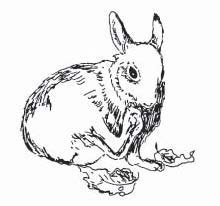 When you’re eating lunch, talk about food chains. The cow ate grass and we eat hamburger. The chicken ate grain and we eat the chicken. The fox ate the rabbit that ate the dandelion leaves. The hawk ate the snake that ate the frog that ate the fly that ate the crumbs from your cookie (that was made from flour from wheat, sugar from cane, butter from cows’ cream developed from the grass the cow ate.) Sooner or later, every food chain comes back to plants. Predators and prey both are part of food chains. Remember the old nursery rhyme: “This is the cat that ate the rat that ate the malt that lay in the house that Jack built.”
When you’re eating lunch, talk about food chains. The cow ate grass and we eat hamburger. The chicken ate grain and we eat the chicken. The fox ate the rabbit that ate the dandelion leaves. The hawk ate the snake that ate the frog that ate the fly that ate the crumbs from your cookie (that was made from flour from wheat, sugar from cane, butter from cows’ cream developed from the grass the cow ate.) Sooner or later, every food chain comes back to plants. Predators and prey both are part of food chains. Remember the old nursery rhyme: “This is the cat that ate the rat that ate the malt that lay in the house that Jack built.”
Predators hunt and eat other animals (prey). Many animals are both predators and prey. Do the activity “Quick Frozen Critters.” Point out it’s not so easy to be a predator: it’s hard to find and catch your dinner. To avoid creating prejudice against predators, talk about them as hungry creatures, not evil ones. Tyrannosaurus Rex was just another hungry fellow, when you come right down to it. Many humans eat meat and are therefore predators too!
Carrying Capacity
Ask what would happen if 10 more people unexpectedly arrived for lunch. Would there be space for them around the table? Would there be enough food for them? Would everybody have to adapt or change a little to incorporate the newcomers? How would the children feel if it were too crowded around the lunch table? What happens in a field or forest when there are too many animals? Some will move away or starve. Talk about carrying capacity (a limited number of animals of a species that any one place can support). Just as a pizza can only feed so many people, a field can only feed so many deer. It is not important that children understand the phrase, just the concept.
Human Impact
How does it affect wild animals when people move into their area? What happened to the wolf, bison,mountain lion, and elk that used to be common in Iowa? What happens when people build houses or roads in places where wild animals live? What would happen to a raccoon if someone cut down the tree where it lived?
Talk about human impact (whatever people do to the world around us has some impact on wildlife too) and interdependence (people and animals exist in a web of interdependence, so anything affecting one affects all). Take a field trip to a construction site and discuss what was there before construction began and how building affects wildlife.
Combine dramatic play with art activities. On a cold day, make a cave with blankets and a card table or couch, then make cave drawings of animals with chalk on black paper. Talk about the ways wild animals were important to our ancestors for food, clothing, and shelter. How have people’s lifestyles been affected by animals? Discuss how animal products have kept us warm (e.g., fur, leather, wool, angora, camel hair, beaver felt, down jackets, quilts).
Look at the impact our lifestyle has on the world and the animals that live on it. Discuss litter. When you take a walk around the block, point out (and pick up when it’s safe to do so) any litter you see. Discuss dangers posed to wildlife by litter. A small animal could get its head stuck inside a jar and die. An animal could cut itself on the sharp edge of a can. Poisons from various household containers can kill animals. Some animals eat bits of litter and die. Released balloons and plastic bags can be especially dangerous this way. Teach children to pick up litter they see and to be sure not to drop any themselves.
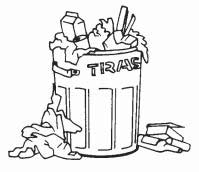 Take a field trip to the recycling center and find out which kinds of materials you can recycle (use again): plastic milk containers, newspaper, general paper, aluminum, cans, glass, and more. Talk about how nature recycles its own litter: dead leaves decay into soil; mushrooms grow on rotting trees; scavenger animals clean up bodies of dead animals, etc. To recycle means to reuse. We need to reform our “throw-away” life style. Ask children to carry a plastic bag filled with all their trash from a single day to demonstrate how much there is. What happens when every person drops that much trash in the earth or the water every day? Our life style is using up our natural resources at a rapid rate, often limiting places where wild animals can live. Read the Dr. Seuss story, “The Lorax.”
Take a field trip to the recycling center and find out which kinds of materials you can recycle (use again): plastic milk containers, newspaper, general paper, aluminum, cans, glass, and more. Talk about how nature recycles its own litter: dead leaves decay into soil; mushrooms grow on rotting trees; scavenger animals clean up bodies of dead animals, etc. To recycle means to reuse. We need to reform our “throw-away” life style. Ask children to carry a plastic bag filled with all their trash from a single day to demonstrate how much there is. What happens when every person drops that much trash in the earth or the water every day? Our life style is using up our natural resources at a rapid rate, often limiting places where wild animals can live. Read the Dr. Seuss story, “The Lorax.”
Extinction
When humans impact animals, leave no place for a species of animal to live, or kill animals faster than they can reproduce and adapt, that kind of animal dies out or becomes extinct. Sing and enact the song: There were five in a bed and the little one said, “Roll over! Roll over!” So they all rolled over and one fell out. “There were four in a bed and the little one said…” A forest (or a marsh, or a prairie, or a lake) is like that bed. If somebody keeps taking over more and more of it, pushing the others out, eventually the others cease to exist. We call this condition extinction.
Often people are the little ones in the bed, asking other animals to move over, but natural disasters and major environmental changes can cause extinctions too. Dinosaurs disappeared before people were even on the scene. Extinction is a naturally occurring process, but human activities have accelerated the rate of extinctions.
When an animal species is in danger of extinction, we call it endangered. Any species that faces serious problems and is at risk of becoming endangered is called threatened. People can make the effort to keep these endangered and threatened species from rolling off the bed onto the floor of extinction.
Adaptation
When people take over an area that once supported wildlife, animals either adapt to change or die. Some animals (e.g., cottontail rabbits, coyotes, raccoons) have adapted to live in close proximity to people in order to survive.
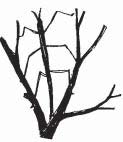 Adaptation means the process of making adjustments to the environment. Many adaptations animals depend on for survival have developed over many, many generations. For example, the duck, goose, and swan have webbed feet for swimming; the heron has long legs for wading, the hawk and eagle have sharp talons and beaks for catching and eating prey; the badger has long claws for digging; the beaver has huge front teeth for gnawing, and so forth.
Adaptation means the process of making adjustments to the environment. Many adaptations animals depend on for survival have developed over many, many generations. For example, the duck, goose, and swan have webbed feet for swimming; the heron has long legs for wading, the hawk and eagle have sharp talons and beaks for catching and eating prey; the badger has long claws for digging; the beaver has huge front teeth for gnawing, and so forth.
A well known kind of adaptation is camouflage, or protective coloration. When hunters or GI’s choose a wardrobe, they consider camouflage. Animals have adapted coloration patterns that help them hide from predators or sneak up unseen on prey.
The walking stick insect looks just like a twig on a bush. The arctic fox changes color to blend in with the seasons. The chameleon changes color to match its surroundings. The bluegill fish has a dark upperside with vertical stripes so that it can hide in vegetation and is difficult for predators to see from above.
Deposit bits of yarn strands of different colors in the yard. It is important to use equal numbers of strands for each color and to count how many you deposit. Tell the children they are birds looking for worms. Which colored worms are hardest to find? Give the children a minute or two to gather a few worms. Then count how many of each color the children collected first. In the grass, red “worms” are usually easier to find than green or beige ones. Discuss why an animal the same color as its surroundings is harder to see. This is the principal of protective coloration or camouflage.
Invite the children to draw an imaginary animal and color it. Where would it live? How is it adapted to survive? What does it eat and how does it get its food? How would it be camouflaged? Post the drawings on the wall.
Habitat
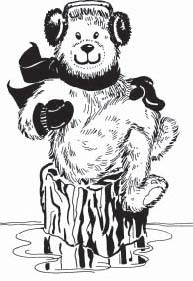 Introduce the concept of habitat at an early age. What do we need to survive? Most of us have houses where we keep food in the refrigerator and water in the well. Animals, like people, need food, shelter, water, and space to live. We call this habitat. If we pollute the water, we destroy the habitat for the fish, and they will die. If we cut down all the trees in the park, the squirrels must move elsewhere or die. Some animals are in danger of becoming extinct because their homes have been destroyed: they don’t have enough food, water, shelter, or space.
Introduce the concept of habitat at an early age. What do we need to survive? Most of us have houses where we keep food in the refrigerator and water in the well. Animals, like people, need food, shelter, water, and space to live. We call this habitat. If we pollute the water, we destroy the habitat for the fish, and they will die. If we cut down all the trees in the park, the squirrels must move elsewhere or die. Some animals are in danger of becoming extinct because their homes have been destroyed: they don’t have enough food, water, shelter, or space.
What kinds of wild animals could have homes in your back yard? Look out the windows and talk about available food, water, shelter, and space. Have the children draw an animal in its habitat. Talk about how we can all help wild animals by making sure they have access to the habitat they need.
Examples include: Feed the birds and provide a bird bath. Leave the brush pile by the garage for shelter for small animals. Raise money to adopt an eagle’s nest or a wolf pack. Clean a stream or pond for wildlife. Help a turtle across the road to a wetland.
There are many different kinds of habitat. You may find different animals living in different places. Wolves and lions can’t live in the city (except in the zoo), but pigeons, spiders, mice, and squirrels can. Peregrine falcons have been released in urban areas because they can survive there, watching from tall buildings to swoop down on other birds like pigeons. The tall buildings replace their original habitat of cliffs along the rivers. It isn’t necessary to study animals in far away places; you can focus on the habitat that surrounds you every day, and the animals that live there.
Anthropomorphism
Young children don’t need to know the term anthropomorphism, but it means the attribution of human characteristics to animals or inanimate objects. Cartoons are rife with anthropomorphism.
When you read children storybooks with animal characters, point out the difference between anthropomorphized animals wearing clothes or eating with utensils and naturalistic animals. It may be important to respect the feelings of animals and avoid causing them pain unnecessarily, but it is also important to see that wild animals do not belong as pets in people houses.
Click for Printable Format
Supplied by GROWLS courtesy of Susan Gilchrist, Wisconsin DNR
One Comment “Teaching Children About Wildlife”
Comments are closed.